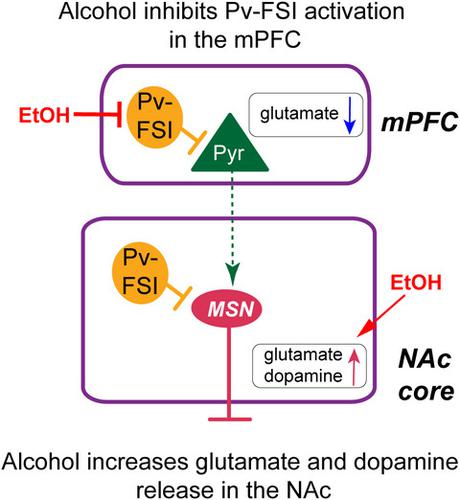当前位置:
X-MOL 学术
›
J. Neurochem.
›
论文详情
Our official English website, www.x-mol.net, welcomes your
feedback! (Note: you will need to create a separate account there.)
Regulation of Pv‐specific interneurons in the medial prefrontal cortex and reward‐seeking behaviors
Journal of Neurochemistry ( IF 4.2 ) Pub Date : 2020-06-27 , DOI: 10.1111/jnc.15106 Lailun Nahar 1 , Caleb A Grant 1 , Cameron Hewett 1 , Diego Cortes 1 , Ashlie N Reker 1 , Seungwoo Kang 2 , Doo-Sup Choi 2 , Hyung W Nam 1
Journal of Neurochemistry ( IF 4.2 ) Pub Date : 2020-06-27 , DOI: 10.1111/jnc.15106 Lailun Nahar 1 , Caleb A Grant 1 , Cameron Hewett 1 , Diego Cortes 1 , Ashlie N Reker 1 , Seungwoo Kang 2 , Doo-Sup Choi 2 , Hyung W Nam 1
Affiliation

|
The corticostriatal circuitry and its glutamate‐γ‐aminobuturic acid (GABA) interactions play an essential role in regulating neuronal excitability during reward‐seeking behavior. However, the contribution of GABAergic interneurons in the corticostriatal circuitry remains unclear. To investigate the role of GABAergic interneurons, we focused on parvalbumin‐expressing fast‐spiking interneurons (Pv‐FSI) in the corticostriatal circuitry using the designer receptors exclusively activated by designer drugs approach in a Pv‐Cre mouse model. We hypothesize that Pv‐FSI activation elicits changes in cortical glutamate levels and reward‐seeking behaviors. To determine molecular and behavioral effects of Pv‐FSI, we performed microdialysis and operant conditioning tasks for sucrose and alcohol rewards. In addition, we also examined how alcohol reward itself affects Pv‐FSI functioning. Interestingly, our microdialysis results demonstrate that alcohol exposure inhibits Pv‐FSI functioning in the medial prefrontal cortex (mPFC) and this consequently can regulate glutamate levels downstream in the nucleus accumbens. For sucrose reward‐seeking behaviors, Pv‐FSI activation in the mPFC increases sucrose self‐administration whereas it does not promote alcohol seeking. For alcohol rewards, however, Pv‐FSI activation in the mPFC results in increased compulsive head entry in operant chambers during devaluation procedures. Overall, our results suggest that not only do Pv‐FSI contribute to changes in the cortical microcircuit and reward‐seeking behaviors but also that alcohol affects Pv‐FSI neurotransmission. Therefore, Pv‐FSI has prompted interest in their role in maintaining a balance in neuronal excitation/inhibition and in regulating reward‐seeking processes such as compulsivity, all of which are important factors for excessive alcohol seeking.
中文翻译:

前额内侧皮层中Pv特定中枢的调节和寻求奖励的行为
糖皮质激素回路及其谷氨酸-γ-氨基丁酸(GABA)相互作用在奖励寻求行为中调节神经元兴奋性中起重要作用。但是,尚不清楚GABA能中神经元在皮质口神经回路中的作用。为了研究GABA能性神经元的作用,我们集中研究了在Pv-Cre小鼠模型中使用由设计药物独家激活的设计受体来表达小白蛋白表达的快速分泌型神经元(Pv-FSI)在皮层神经系统中的作用。我们假设Pv‐FSI激活引起皮层谷氨酸水平和寻求奖励行为的改变。为了确定Pv-FSI的分子和行为效应,我们对蔗糖和酒精进行了微透析和操作性调节任务。此外,我们还研究了酒精奖励本身如何影响Pv-FSI的功能。有趣的是,我们的微透析结果表明,酒精暴露抑制了前额叶内侧皮层(mPFC)中的Pv-FSI功能,因此可以调节伏伏核下游的谷氨酸水平。对于寻求蔗糖的奖励行为,mPFC中的Pv-FSI激活会增加蔗糖的自我管理,而不会促进寻求酒精的行为。但是,对于酒精饮料奖励,在贬值过程中,mPFC中的Pv-FSI激活会导致强制性头部进入手术室。总体而言,我们的研究结果表明,Pv-FSI不仅有助于皮质微回路的改变和寻求奖励的行为,而且酒精还会影响Pv-FSI的神经传递。因此,
更新日期:2020-06-27
中文翻译:

前额内侧皮层中Pv特定中枢的调节和寻求奖励的行为
糖皮质激素回路及其谷氨酸-γ-氨基丁酸(GABA)相互作用在奖励寻求行为中调节神经元兴奋性中起重要作用。但是,尚不清楚GABA能中神经元在皮质口神经回路中的作用。为了研究GABA能性神经元的作用,我们集中研究了在Pv-Cre小鼠模型中使用由设计药物独家激活的设计受体来表达小白蛋白表达的快速分泌型神经元(Pv-FSI)在皮层神经系统中的作用。我们假设Pv‐FSI激活引起皮层谷氨酸水平和寻求奖励行为的改变。为了确定Pv-FSI的分子和行为效应,我们对蔗糖和酒精进行了微透析和操作性调节任务。此外,我们还研究了酒精奖励本身如何影响Pv-FSI的功能。有趣的是,我们的微透析结果表明,酒精暴露抑制了前额叶内侧皮层(mPFC)中的Pv-FSI功能,因此可以调节伏伏核下游的谷氨酸水平。对于寻求蔗糖的奖励行为,mPFC中的Pv-FSI激活会增加蔗糖的自我管理,而不会促进寻求酒精的行为。但是,对于酒精饮料奖励,在贬值过程中,mPFC中的Pv-FSI激活会导致强制性头部进入手术室。总体而言,我们的研究结果表明,Pv-FSI不仅有助于皮质微回路的改变和寻求奖励的行为,而且酒精还会影响Pv-FSI的神经传递。因此,









































 京公网安备 11010802027423号
京公网安备 11010802027423号